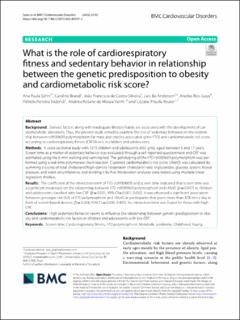| dc.contributor.author | Sehn, Ana Paula | |
| dc.contributor.author | Brand, Caroline | |
| dc.contributor.author | de Castro Silveira, João Francisco | |
| dc.contributor.author | Andersen, Lars Bo | |
| dc.contributor.author | Gaya, Anelise Reis | |
| dc.contributor.author | Todendi, Pâmela Ferreira | |
| dc.contributor.author | de Moura Valim, Andréia Rosane | |
| dc.contributor.author | Reuter, Cézane Priscila | |
| dc.date.accessioned | 2022-10-06T08:27:03Z | |
| dc.date.available | 2022-10-06T08:27:03Z | |
| dc.date.created | 2022-05-23T13:51:20Z | |
| dc.date.issued | 2022 | |
| dc.identifier.citation | Sehn, A. P., Brand, C., de Castro Silveira, J. F., Andersen, L. B., Gaya, A. R., Todendi, P. F., de Moura Valim, A. R., & Reuter, C. P. (2022). What is the role of cardiorespiratory fitness and sedentary behavior in relationship between the genetic predisposition to obesity and cardiometabolic risk score? BMC Cardiovascular Disorders, 22(1):92. | en_US |
| dc.identifier.issn | 1471-2261 | |
| dc.identifier.uri | https://hdl.handle.net/11250/3024201 | |
| dc.description.abstract | Background
Genetic factors along with inadequate lifestyle habits are associated with the development of cardiometabolic alterations. Thus, the present study aimed to examine the role of sedentary behavior on the relationship between rs9939609 polymorphism (fat mass and obesity-associated gene-FTO) and cardiometabolic risk score according to cardiorespiratory fitness (CRF) levels in children and adolescents.
Methods
A cross-sectional study with 1215 children and adolescents (692 girls), aged between 6 and 17 years. Screen time as a marker of sedentary behavior was evaluated through a self-reported questionnaire and CRF was estimated using the 6-min walking and running test. The genotyping of the FTO rs9939609 polymorphism was performed using a real-time polymerase chain reaction. Clustered cardiometabolic risk score (cMetS) was calculated by summing z-scores of total cholesterol/high-density lipoprotein cholesterol ratio, triglycerides, glucose, systolic blood pressure, and waist circumference, and dividing it by five. Moderation analyses were tested using multiple linear regression models.
Results
The coefficient of the interaction term of FTO (rs9939609) and screen time indicated that screen time was a significant moderator on the relationship between FTO rs9939609 polymorphism and cMetS (p = 0.047) in children and adolescents classified with low CRF (β = 0.001; 95% CI = 0.001; 0.002). It was observed a significant association between genotype risk (AA) of FTO polymorphism and cMetS, in participants that spent more than 378 min a day in front of screen-based devices (β = 0.203; 95% CI = 0.000; 0.405). No interaction term was found for those with high CRF.
Conclusions
High sedentary behavior seems to influence the relationship between genetic predisposition to obesity and cardiometabolic risk factors in children and adolescents with low CRF. | en_US |
| dc.language.iso | eng | en_US |
| dc.publisher | BMC | en_US |
| dc.rights | Navngivelse 4.0 Internasjonal | * |
| dc.rights.uri | http://creativecommons.org/licenses/by/4.0/deed.no | * |
| dc.title | What is the role of cardiorespiratory fitness and sedentary behavior in relationship between the genetic predisposition to obesity and cardiometabolic risk score? | en_US |
| dc.type | Peer reviewed | en_US |
| dc.type | Journal article | en_US |
| dc.description.version | publishedVersion | en_US |
| dc.rights.holder | © The Author(s) 2022. | en_US |
| dc.source.volume | 22 | en_US |
| dc.source.journal | BMC Cardiovascular Disorders | en_US |
| dc.source.issue | 1 | en_US |
| dc.identifier.doi | 10.1186/s12872-022-02537-5 | |
| dc.identifier.cristin | 2026566 | |
| dc.source.articlenumber | 92 | en_US |
| cristin.ispublished | true | |
| cristin.fulltext | original | |
| cristin.qualitycode | 1 | |

